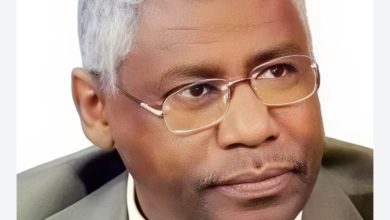A Reading of the Text “Tasis” (Foundation) of Nairobi: Secular Fundamentalism (2-2)

By Abdullah Ali Ibrahim
Our current understanding of religion is “a product of secular resentment that has taken hold of the modern elite.” Religion has often been treated with indifference or outright hostility, which is the root of secular fundamentalism.
— John Esposito, Georgetown University
Secularism of the State
Abdulaziz al-Hilu’s prize, which tempted him to “establish” (Tasis), was the fact that his document explicitly stated the demand for a “secular state” (in the preamble) without any hesitation—a stance unprecedented in Sudanese history. Secularism of the state is a fundamental doctrine for al-Hilu, though he has sometimes substituted it with “separation of religion from the state” in agreements signed with a broad spectrum of Sudanese political parties, including one with General Abdel Fattah al-Burhan, Chairman of the Sovereign Council, in 2021.
As long as the political winds blew in favor of secularism, al-Hilu pushed his movement’s demand that the upcoming constitution include “supra-constitutional principles” such as secularism—principles that cannot be amended like other constitutional provisions. These supra-constitutional principles are safeguarded, and if any group attempts to change them, Sudanese communities affected by such a change would have the right to withdraw from the nation and exercise their right to self-determination (Chapter 1, Articles 3 and 7).
Many believe that some form of separation between religion and state is inevitable, as evidenced by its repeated mention in the Juba Peace Agreement. However, al-Hilu’s insistence on deifying secularism—shielding it from political contestation, even at the expense of democracy—is an exceptional case of idolizing a political principle devoid of context. His approach suggests an affliction with secular fundamentalism, a term John Esposito, a professor at Georgetown University, used as a warning, much like his caution against religious fundamentalism. Esposito argues that our contemporary understanding of religion is shaped by “a secular resentment that has taken hold of the modern elite,” leading to widespread indifference or even open hostility toward religion.
Esposito’s warning about secular fundamentalism comes in the context of a long-standing reassessment of the relationship between religion and secularism. One of the key scholars involved in this debate is the American academic Craig Calhoun, who challenges the notion that secularism is entirely divorced from religion. He states, “We have often taken secularism as a condition of absence—that it is simply what remains once religion has vanished, not only from politics but from existence altogether.” This view echoes the early French Revolution’s stance, which sought to replace religion with what it considered a superior alternative—at least for a time.
Similarly, New York Times journalist Nicholas Kristof highlighted the cultural divide between liberal media and “born-again” Americans following the religious rhetoric of President George W. Bush. He pointed out that 48% of Americans believe in God’s creation of the world in seven days, while only 28% adhere to Darwin’s theory. Moreover, two-thirds or more of Americans believe in the existence of Satan more than they trust Darwin’s theory. This religious segment of society lives in cultural isolation from liberals. Among the best-selling books in the U.S. is a Christian series about the end of the world, which has sold 50 million copies, while one of the most-watched TV personalities is an evangelical preacher whose sermons reach 190 countries. The persistence of religious influence has led some to describe Bush’s era as “the Fourth Great Awakening” in American history. The return of religion, in its various forms, is far from over.
Re-Establishment
The Tasis document calls for a complete re-establishment of all military, security, and civil service institutions from scratch. According to the document, a new professional and national army will be formed, representing Sudan’s diverse demographics and placed under civilian leadership. This army would be free of political, regional, or ethnic loyalties and would have no involvement in politics or the economy. Such a re-establishment will only occur when the Tasis alliance prevails and takes control of the state (Chapter 1, Article 14). Until then, the armed groups that signed the document will retain their forces, continuing what the text describes as “armed struggle as a legitimate means of resistance and the fight for change and the building of Sudan” (Chapter 1, Article 20). This situation is reminiscent of the tale from al-Jahiz, in which misers sat around a pot of boiling water, each tying his piece of meat to a string and lowering it into the pot separately, ensuring that their food remained separate despite sharing the same pot.
The Islamist “Boogeyman”
The Tasis document appears to be entirely motivated by the fear of Islamists, particularly “the Kizan” (a Sudanese term for Islamists). It not only calls for the dissolution of the National Congress Party and the Islamic Movement (Chapter 1, Article 32), but it also explicitly prohibits the formation of any political party based on religion. However, the document may have miscalculated, assuming that “the Kizan”, who indeed established an oppressive political regime, are the only ones who wish for religion to play a role in governance. In reality, many Sudanese Muslims still seek to apply their religious beliefs in their own lives, without imposing them on others. The issue of religious legislation remains an open debate, far from settled.
The Tasis document commits itself to “the principle of peaceful political activity in the new Sudan, based on the foundations and principles of democratic governance and constitutional legitimacy” (Chapter 1, Article 19). However, it contradicts this principle by criminalizing “the exploitation of religion for political purposes.” This stance is inherently undemocratic because democracy is based on open political competition where voters can judge political programs for themselves. The insistence on separating religion from politics stems from the problematic term “political Islam”, which has been useful for opponents of the Islamic project to suggest that another, non-political Islam exists—a misleading distinction.
This fear of Islamism borders on obsession. Not only does Tasis entrench secularism as a supra-constitutional principle, granting affected groups the right to secede if it is violated, but it also criminalizes the mere formation of a party that advocates for an alternative to secularism. If grievances against the Inqaz (the Islamist Salvation regime) are the main justification for this approach, then consistency would demand that Tasis also criminalize ethnic-based parties. Ethnic and tribal divisions have wreaked as much havoc on Sudan as religiously motivated politics. However, the drafters of Tasis did not consider banning ethnically based political movements—likely because the Nairobi meeting was attended by numerous ethnic and tribal factions. Notably, one of the signatories represents the Beja Congress, which advocates for the interests of the Beja people in eastern Sudan.
Conclusion
The elite’s apprehension about the Nairobi alliance and its potential to divide Sudan stems from their implicit understanding of its broader implications. Those who analyze Tasis in its historical and contemporary context may worry not only for Sudan but also for its supporters, who seem driven by grievances against “the Kizan”, as though Sudan’s salvation lies solely in their eradication. By fixating on countering the Islamists, they risk becoming defined by their opposition rather than by a vision for Sudan’s future. Sudan deserves a more courageous political imagination—one that acknowledges the Inqaz regime as a chapter in history rather than an ever-looming specter. Otherwise, as one observer put it, “we remain stuck in exaggerated fears and avoidable misjudgments.”



